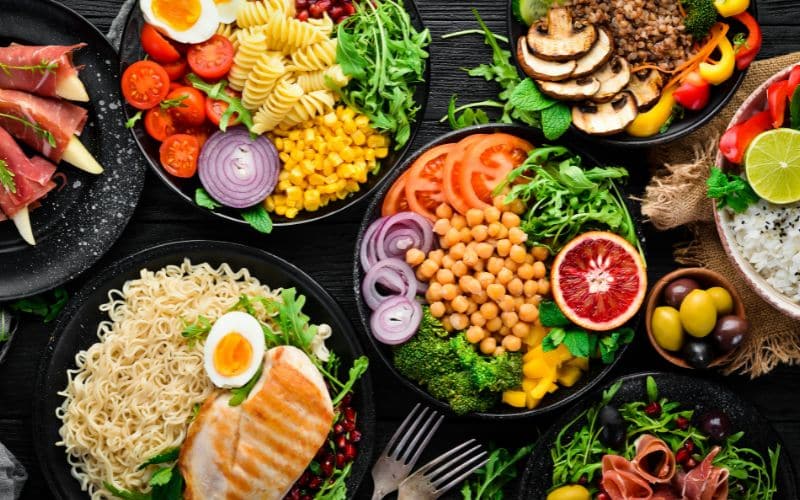A lot of people use the terms "diet" and "meal" interchangeably, but they actually have different meanings. A diet refers to a specific eating regimen that is usually designed to achieve a particular goal, such as weight loss or better health. A meal, on the other hand, is simply a single instance of eating food.
While it's true that what you eat for a meal can be part of your diet, the two terms are not synonymous. A meal is just one part of your overall diet, which includes all the food you eat over a certain period of time. Understanding the difference between a diet and a meal can help you make more informed choices about what you eat and how you structure your eating habits.
Contents
Understanding the Concept of a Diet
Definition of a Diet
A diet is the sum of food and drink consumed by an individual or group. According to the World Health Organization (WHO), a healthy diet is one that provides the necessary nutrients to maintain good health, reduces the risk of chronic diseases, and supports growth and development.
Purpose and Goal of a Diet
The primary goal of a diet is to maintain or improve overall health. A diet can also be used to achieve specific health goals, such as weight loss, reducing cholesterol levels, or managing diabetes. A well-planned diet can help individuals achieve their health goals by providing the necessary nutrients and reducing the intake of harmful substances.
Types of Diets

There are various types of diets that individuals can follow to achieve their health goals. Some of the most common types of diets include:
- Mediterranean diet: This diet emphasizes the consumption of fruits, vegetables, whole grains, legumes, nuts, and olive oil. It limits the intake of red meat and processed foods.
- Ketogenic diet: This diet is a high-fat, low-carbohydrate diet that is designed to put the body in a state of ketosis. This diet is often used for weight loss and to manage epilepsy.
- Vegan diet: This diet excludes all animal products and emphasizes the consumption of fruits, vegetables, whole grains, legumes, and nuts.
- Paleo diet: This diet emphasizes the consumption of whole, unprocessed foods that were available to our ancestors during the Paleolithic era. It limits the intake of processed foods, grains, and dairy products.
It's important to note that not all diets are suitable for everyone. Before starting a new diet, individuals should consult with a healthcare professional to ensure that the diet is safe and appropriate for their specific health needs.
Understanding the Concept of a Meal
Definition of a Meal
A meal is a specific set of food items consumed at a particular time of day or occasion. It usually consists of one or more dishes served together, and it can be eaten alone or with others. The definition of a meal can vary depending on culture, religion, and personal preferences. Some people consider a meal to be a full dinner with multiple courses, while others may consider a sandwich or a bowl of cereal to be a meal.
Purpose and Goal of a Meal
The purpose of a meal is to provide the body with the necessary nutrients and energy to function properly. A well-balanced meal should contain a variety of food groups, including carbohydrates, proteins, healthy fats, vitamins, and minerals. The goal of a meal is to satisfy hunger and provide satiety, which can help prevent overeating and snacking between meals.
Types of Meals

There are different types of meals that people consume throughout the day, including:
- Breakfast: Typically the first meal of the day, eaten in the morning. It can consist of a variety of foods, such as cereal, eggs, toast, fruit, and yogurt.
- Lunch: Usually eaten in the middle of the day, this meal can be a light or heavy meal depending on personal preferences. It can include sandwiches, salads, soups, or leftovers from dinner.
- Dinner: Often considered the main meal of the day, dinner is usually eaten in the evening and can consist of multiple courses. It can include meat, fish, vegetables, grains, and desserts.
- Snacks: Consumed between meals, snacks can be a small portion of food that provides a quick burst of energy. They can consist of fruits, nuts, crackers, or other small items.
In conclusion, understanding the concept of a meal is essential for maintaining a healthy and balanced diet. By knowing the definition of a meal, its purpose, and different types, one can make informed choices about what to eat and when to eat it.
Key Differences Between a Diet and a Meal
When it comes to eating habits, there are two main approaches that people follow: a diet and a meal. While both approaches involve consuming food, they differ in several ways. In this section, we will explore the key differences between a diet and a meal.
Time Frame
One of the main differences between a diet and a meal is the time frame. A diet is typically a long-term plan that involves specific rules and restrictions regarding what you can and cannot eat. Diets often have a specific goal, such as weight loss or improved health, and may require you to track your food intake and count calories or macronutrients.
In contrast, a meal is a single instance of eating that does not involve any specific rules or restrictions. Meals can be planned or spontaneous, and they can vary in size and composition depending on your appetite and preferences.
Variety and Flexibility
Another key difference between a diet and a meal is the level of variety and flexibility. Diets often involve strict rules regarding what foods you can and cannot eat, which can limit your food choices and lead to boredom or cravings. Some diets also require you to eliminate entire food groups, which can result in nutrient deficiencies and other health problems.
In contrast, meals offer more variety and flexibility, allowing you to choose from a wide range of foods and flavors. You can mix and match different ingredients and flavors to create a meal that suits your tastes and preferences. Additionally, meals can be adjusted to accommodate changes in your appetite, schedule, or nutritional needs.
Health Implications
Finally, the health implications of a diet and a meal differ significantly. Diets may have specific health benefits, such as weight loss or improved blood sugar control, but they can also have negative side effects, such as nutrient deficiencies or disordered eating patterns. Some diets may also be unsustainable in the long term, leading to weight regain or other health problems.
In contrast, meals offer a more balanced and sustainable approach to eating. By choosing a variety of nutrient-dense foods and listening to your body's hunger and fullness signals, you can ensure that you are getting the nutrients you need while also enjoying your food. Additionally, meals can be adapted to suit different health goals, such as improving digestion, reducing inflammation, or supporting athletic performance.
Overall, while both diets and meals involve eating food, they differ in several ways, including time frame, variety and flexibility, and health implications. By understanding these differences, you can choose an approach to eating that suits your needs and preferences.
Common Misconceptions About Diets and Meals

There are many misconceptions about diets and meals that can lead to confusion and frustration when trying to make healthy food choices. Here are a few common misconceptions:
Misconception 1: Diets are only for weight loss
Many people think of diets as something you do when you want to lose weight. While it's true that some diets are designed for weight loss, the term "diet" simply refers to the types of food that a person regularly eats. Everyone has a diet, whether they are consciously trying to lose weight or not. Eating a healthy, balanced diet is important for overall health and can help prevent chronic diseases like heart disease and diabetes.
Misconception 2: Meals must be perfectly balanced
While it's important to aim for a balanced diet overall, each individual meal doesn't need to be perfectly balanced. For example, if you have a meal that is higher in carbohydrates, you can balance it out with a meal that is higher in protein and healthy fats later in the day. The key is to aim for balance over the course of the day or week, rather than trying to achieve it with every single meal.
Misconception 3: Healthy eating is expensive
Eating healthy doesn't have to be expensive. While some healthy foods like fresh produce can be more expensive, there are plenty of affordable options like frozen fruits and vegetables, canned beans, and whole grains. Planning ahead and cooking at home can also help save money. Plus, investing in your health now can help prevent costly health problems down the line.
Misconception 4: All fats are bad
While it's true that some types of fats, like trans fats, can be harmful to health, not all fats are bad. In fact, some types of fats like monounsaturated and polyunsaturated fats are actually beneficial for heart health. It's important to aim for a balance of different types of fats in your diet and avoid consuming too much saturated and trans fats.
Misconception 5: You need to cut out all your favorite foods
Healthy eating doesn't have to mean giving up all your favorite foods. In fact, allowing yourself to enjoy your favorite foods in moderation can help you stick to a healthy eating plan long-term. The key is to aim for balance and moderation, rather than strict deprivation.
Conclusion
In conclusion, it is important to understand the difference between a diet and a meal plan. A diet is a restrictive eating plan that often focuses on calorie reduction or the elimination of certain food groups. On the other hand, a meal plan is a flexible guide that provides a framework for healthy eating habits.
While diets may result in short-term weight loss, they are often unsustainable and can lead to negative health consequences. In contrast, a meal plan can help individuals establish long-term healthy eating habits that can lead to improved overall health and wellbeing.
It is important to note that a meal plan should be tailored to an individual's specific needs and preferences. This may include taking into account any food allergies or intolerances, cultural or religious dietary restrictions, and personal taste preferences.
Additionally, it is important to prioritize nutrient-dense foods in any meal plan. This includes fruits, vegetables, whole grains, lean proteins, and healthy fats. By incorporating a variety of these foods into meals and snacks, individuals can ensure they are meeting their nutritional needs while also enjoying a satisfying and flavorful diet.
Overall, focusing on a healthy meal plan rather than a restrictive diet can lead to sustainable and positive changes in an individual's health and wellbeing.






